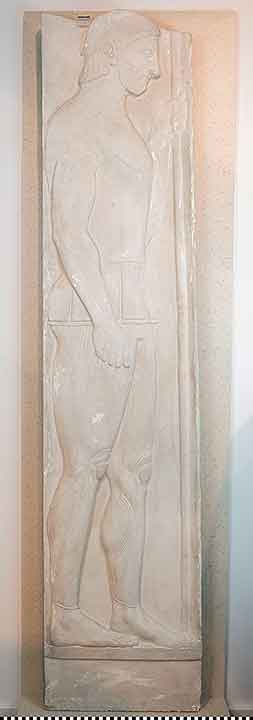Plaster Cast Frieze: Grave Stele of Aristion
1911.03.0002
Detailed Images
Basic Information
| Artifact Identification | Plaster Cast Frieze: Grave Stele of Aristion (1911.03.0002) |
|---|---|
| Classification/ Nomenclature |
|
| Artist/Maker | Aristokles |
| Geographic Location | |
| Period | Late Archaic |
| Date | 520-510 BCE |
| Culture | Archaic Greek |
| Location | On Exhibitin the Ancient Mediterranean exhibit |
Physical Analysis
| Dimension 1 (Height) | 198.9 cm |
|---|---|
| Dimension 2 (Width) | 45.0 cm |
| Dimension 3 (Depth) | 5.9 cm |
| Weight | waived g |
| Measuring Remarks | N/A |
| Materials | Plaster |
| Manufacturing Processes | Cast |
Research Remarks
| Description | The top part with a crowning (most likely a palmette) is missing. Aristion is depicted as a bearded hoplite facing right. He wears a short thin chiton above which is a corselet decorated with painted ornaments including maeanders, zigzags, and a star on the shoulder. He wears an Attic helmet (with its top imssing) on his head and greaves on his shins. His right arm hangs down and he holds a spear in his left hand. He stands bare foot on a projecting horizontal band on which is inscribed; ergon Aristokleous (the work of Aristokles). The beard is rendered by wavy incised lines and the hair is combed into spiral curls with volute terminals. The face is terracotta color with traces of red at the bottom of the slab. |
|---|---|
| Published Description | Under Review |
| Bibliography | Aldrete, Gregory S., Scott Bartell, Alicia Aldrete. 2013. Reconstructing Ancient Linen Body Armor. Unraveling the Linothorax Mystery. Baltimore: Johns Hopkins University Press, 195–96, no. S-4. |
Artifact History
| Credit Line/Dedication | Classical Museum Purchase |
|---|---|
| Reproduction | yes, Original Pentelic marble found in 1839 at Velanideza in Attica not far from the marble stele of Lyseas. Displayed in the Athens National Museum, no. 29. |
Contact
All information about our collection is constantly reviewed and updated. Please contact Dery Martínez-Bonilla, Registrar, if there is any information you are looking for that isn't currently online.
